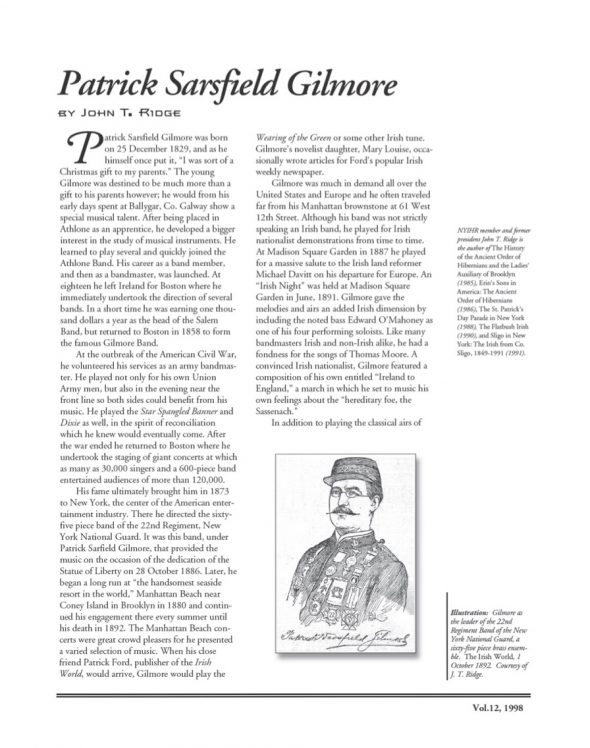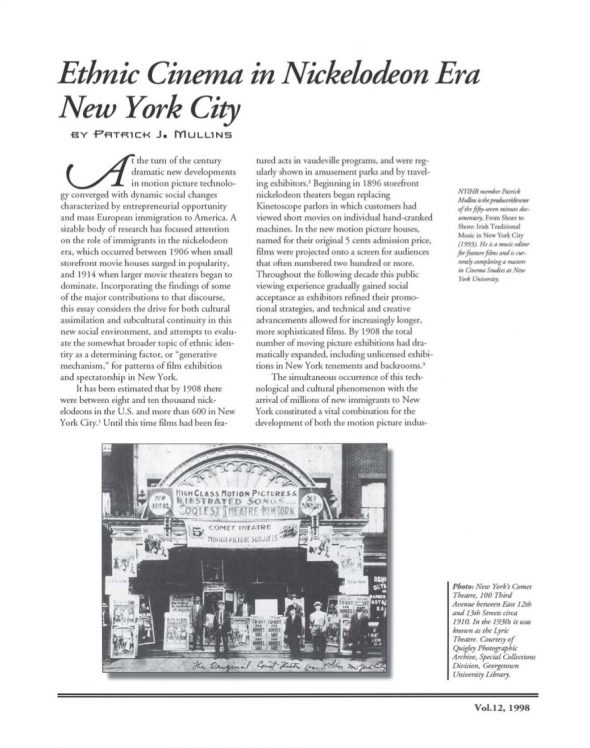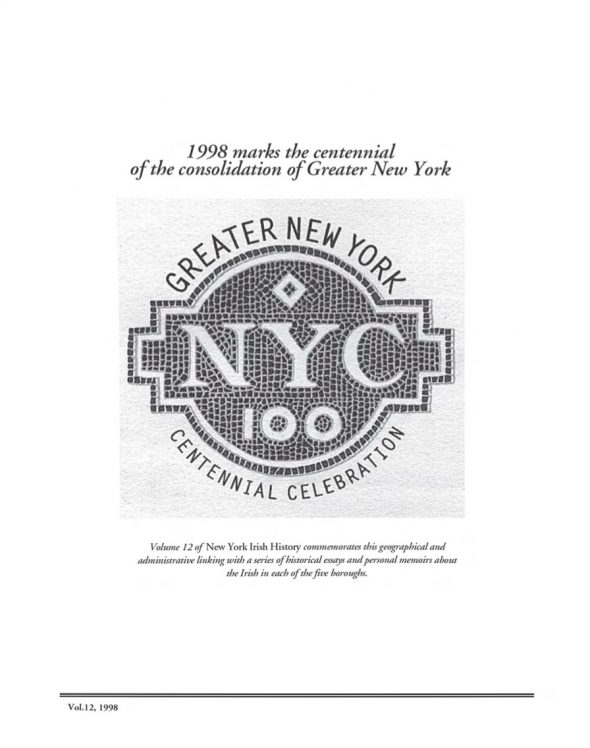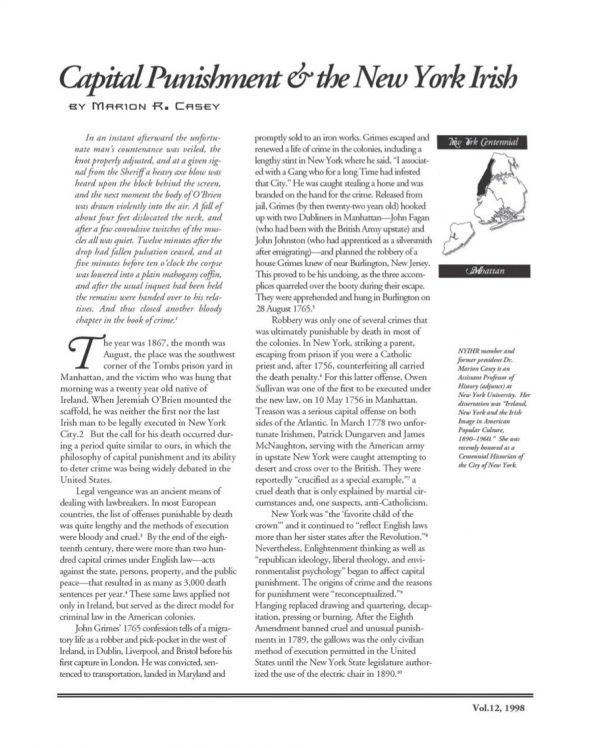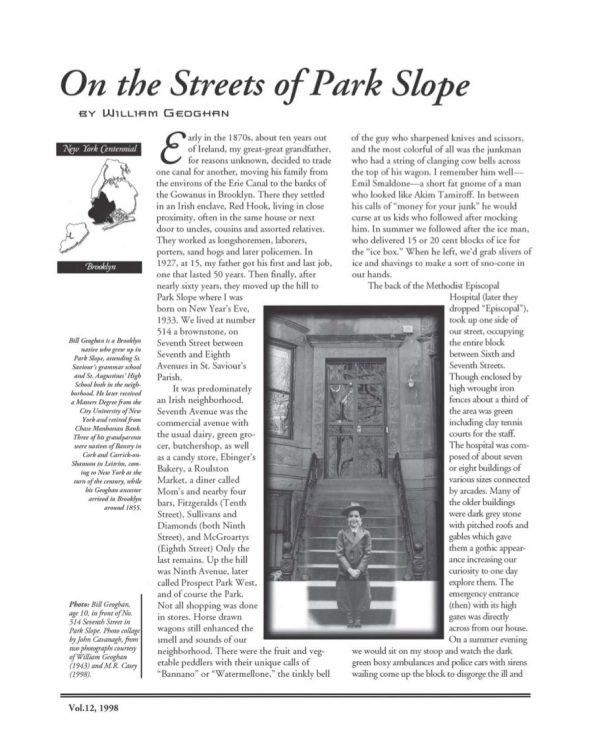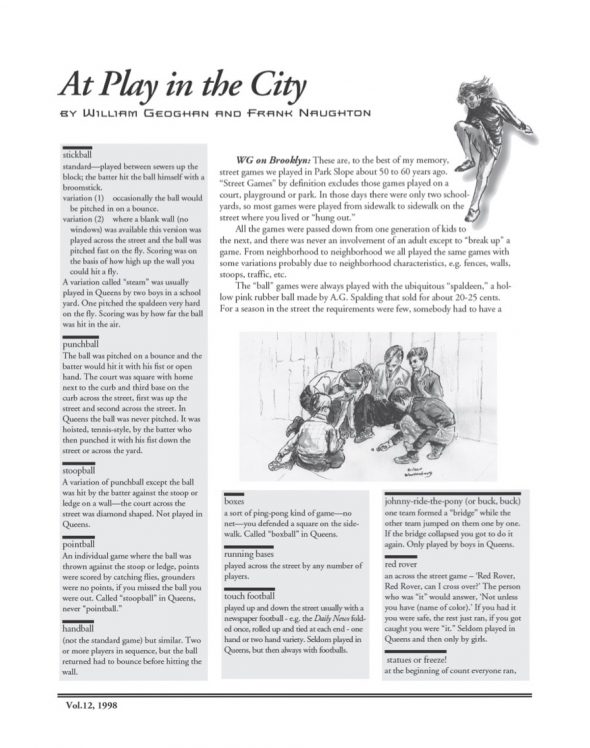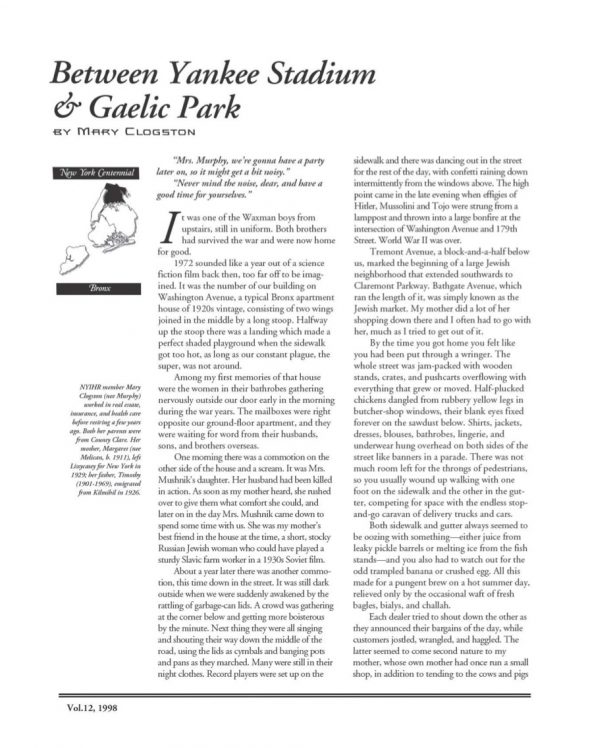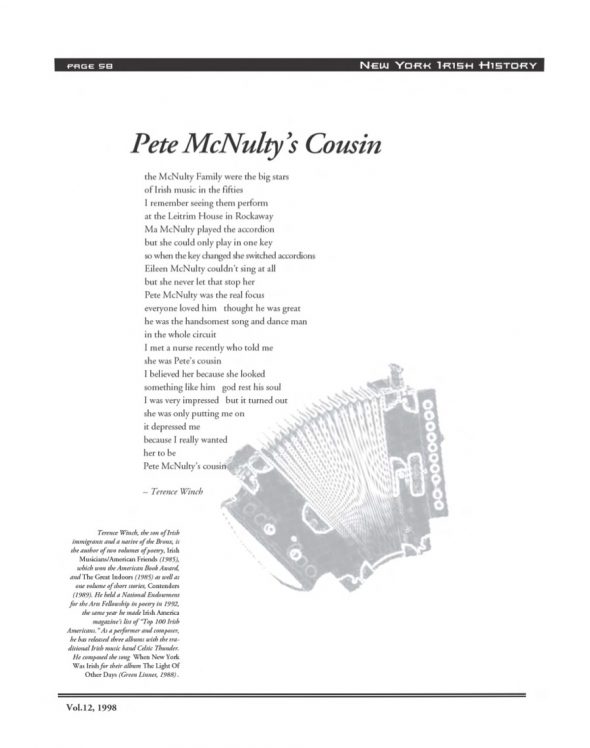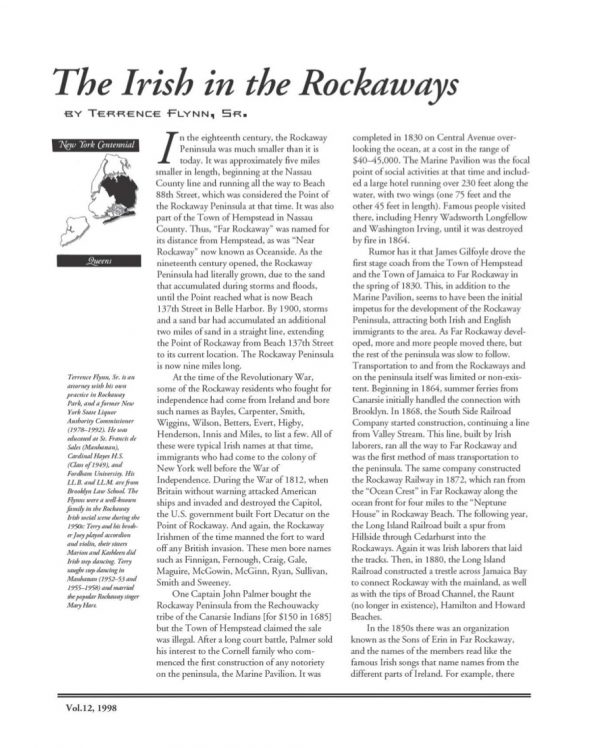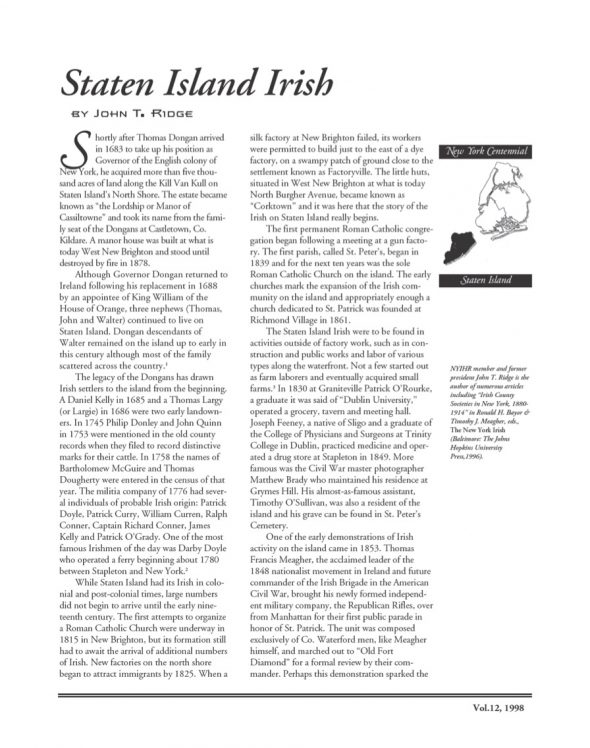New York Irish History Roundtable - Journal Articles
Patrick Sarsfield Gilmore
Author: John T. Ridge
Publication Year: 1998
Journal Volume: 12
Article Reference: NYIHR-V12-06
Patrick Sarsfield Gilmore was born on 25 December 1829, and as he himself once put it, "I was sort of a Christmas gift to my parents." The young Gilmore was destined to be much more than a gift to his parents however; he would from his early days spent at Ballygar, Co. Galway show a special musical talent. After being placed in Athlone as an apprentice, he developed a bigger interest in the study of musical instruments. He learned to play several and quickly joined the Athlone Band. His career as band member, and then as a... [Read Full Article]
Ethnic Cinema in Nickelodeon Era New York City
Author: Patrick J. Mullins
Publication Year: 1998
Journal Volume: 12
Article Reference: NYIHR-V12-07
The turn of the century dramatic new developments in motion picture technology converged with dynamic social changes characterized by entrepreneurial opportunity and mass European immigration to America. A sizable body of research has focused attention on the role of immigrants in the nickelodeon era, which occurred between 1906 when small storefront movie houses surged in popularity, and 1914 when larger movie theaters began to dominate. Incorporating the findings of some of the major contributions to that discourse, this essay considers... [Read Full Article]
1998 Marks the Centennial of the Consolidation of Greater New York
Author: New York Irish History Roundtable
Publication Year: 1998
Journal Volume: 12
Article Reference: NYIHR-V12-08
Vol.12, 1998 1998 marks the centennial of the consolidation of Greater New York.
In 1874 Westchester County ceded portions of the West Bronx. "The City" annexed the rest of the Bronx in 1895. Brooklyn was city in its own right from 1834, the third largest in the country by 1860. Queens extended east as far as the town of Oyster Bay.
Staten Island was isolated and periodically subject to claims by East Jersey.
In 1898 Manhattan, the Bronx, Brooklyn, Queens and Richmond joined together to become Greater New York... [Read Full Article]
Capital Punishment & the New York Irish
Author: Marion R. Casey
Publication Year: 1998
Journal Volume: 12
Article Reference: NYIHR-V12-09
In an instant afterward the unfortunate man's countenance was veiled, the knot properly adjusted, and at a given signal from the Sheriff a heavy axe blow was heard upon the block behind the screen, and the next moment the body of O'Brien was drawn violently into the air. A fall of about four feet dislocated the neck, and after a few convulsive twitches of the muscles all was quiet. Twelve minutes after the drop had fallen pulsation ceased, and at five minutes before ten o'clock the corpse was lowered into a plain mahogany... [Read Full Article]
On the Streets of Park Slope
Author: William Geoghan
Publication Year: 1998
Journal Volume: 12
Article Reference: NYIHR-V12-10
Saviour's grammar school and St. Augustines' High School both in the neighborhood. He later received a Masters Degree from the City University of New York and retired from Chase Manhattan Bank. Three of his grandparents were natives of Bantry in Cork and Carrick-on-Shannon in Leitrim, coming to New York at the turn of the century, while his Geoghan ancestor arrived in Brooklyn around 1855. Photo: Bill Geoghan, age 10, in front of No. 514 Seventh Street in Park Slope. Photo collage by John Cavanagh, from two photographs courtesy of... [Read Full Article]
At Play in the City
Author: William Geoghan And Frank Naughton
Publication Year: 1998
Journal Volume: 12
Article Reference: NYIHR-V12-11
Stickball standard - played between sewers up the block; the batter hit the ball himself with a broomstick. variation (1) occasionally the ball would be pitched in on a bounce. variation (2) where a blank wall (no windows) was available this version was played across the street and the ball was pitched fast on the fly. Scoring was on the basis of how high up the wall you could hit a fly.
A variation called "steam" was usually played in Queens by two boys in a school yard. One pitched the spaldeen very hard on the fly. Scoring... [Read Full Article]
Between Yankee Stadium & Gaelic Park
Author: Mary Clogston
Publication Year: 1998
Journal Volume: 12
Article Reference: NYIHR-V12-12
NYIHR member Mary Clogston (nee Murphy) worked in real estate, insurance, and health care before retiring a few years ago. Both her parents were from County Clare. Her mother, Margaret (nee Melican, b. 1911), left Lissycasey for New York in 1929; her father, Timothy (1901-1969), emigrated from Kilmihil in 1926. "Mrs. Murphy, we're gonna have a party later on, so it might get bit noisy. "Never mind the noise, dear, and have a gIood time for yourselves." was one of the Waxman boys from upstairs, still in uniform. Both... [Read Full Article]
Pete McNultys Cousin
Author: Terence Winch
Publication Year: 1998
Journal Volume: 12
Article Reference: NYIHR-V12-13
The McNulty Family were the big stars of Irish music in the fifties remember seeing them perform at the Leitrim House in Rockaway Ma McNulty played the accordion but she could only play in one key SO when the key changed she switched accordions Eileen McNulty couldn't sing all but she never let that stop her Pete McNulty was the real focus everyone loved him thought he was great he was the handsomest song and dance man in the whole circuit a met a nurse recently who told me she was Pete's cousin I believed her because she looked... [Read Full Article]
The Irish in the Rockaways
Author: Terrence Flynn, Sr.
Publication Year: 1998
Journal Volume: 12
Article Reference: NYIHR-V12-14
Terrence Flynn, Sr. is an attorney with his own practice in Rockaway Park, and a former New York State Liquor Authority Commissioner (1978-1992). He was educated at St. Francis de Sales (Manhattan), Cardinal Hayes H.S. (Class of 1949), and Fordham University. His LL.B. and LL.M. are from Brooklyn Law School. The Flynns were a well-known family in the Rockaway Irish social scene during the 1950s: Terry and his brother Joey played accordion and violin, their sisters Marion and Kathleen did Irish step dancing. Terry taught step dancing in... [Read Full Article]
Staten Island Irish
Author: John T. Ridge
Publication Year: 1998
Journal Volume: 12
Article Reference: NYIHR-V12-15
Shortly after Thomas Dongan arrived in 1683 to take up his position as Governor of the English colony of New York, he acquired more than five thousand acres of land along the Kill Van Kull on Staten Island's North Shore. The estate became known as "the Lordship or Manor of Cassiltowne" and took its name from the family seat of the Dongans at Castletown, Co. Kildare. A manor house was built at what is today West New Brighton and stood until destroyed by fire in 1878. Although Governor Dongan returned to Ireland following his... [Read Full Article]

